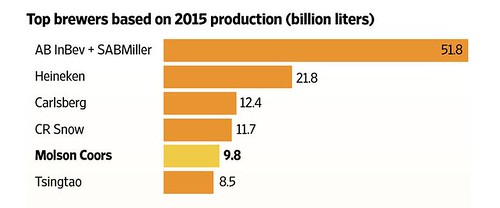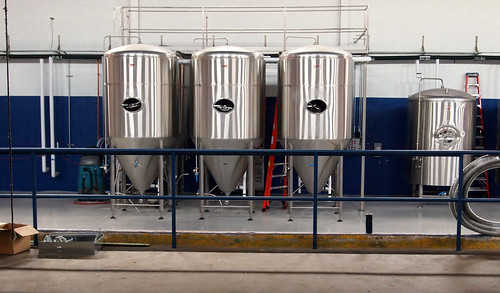
A bi-weekly, non-comprehensive roundup
of news of beer and other things.
Weeks 43/44
23 October - 5 November 2016
- 3 November 2016
The Chicago Cubs Major League Baseball team wins the 2016 World Series, ending its 108-year World Series championship drought, the longest such occurrence in Major League Baseball and, in fact, in all major North American sports.
—Via New York Times. - 3 November 2016
The preliminary results of the 2016 hops harvest in Germany show about 42,700 tons produced, 4,600 tons of which would be alpha, that is, bittering hops. If so, it would be a record harvest.
—Via HVG German Hops. - 3 November 2016
The blob! Anheuser-Busch InBev buys another American 'craft' brewery: Texas-based, five-year old, Karbach Brewing (which produced 55,000 barrels in 2015).
— Via All About Beer.
— Map of Anheuser-Busch InBev's American 'craft' brewery acquisitions to date, via Jeff Alworth at Beervana. - 2 November 2016
Analysis of results of the 2016 Great American Beer Festival.- The five states whose breweries won the most medals were: California, at 68; Colorado, 38; Oregon, 21; North Carolina, 17; and Virginia, at 14.
- Over the last three years, thirty states have entered two hundred or more entries, and none had ever won even 6 percent of those entries until Virginia’s performance this year.
- The style most entered was American-style IPA. No surprise there, but Watson notes that its entries were down from 4.98 percent to 4.27 percent of all entries.
- American-Style Sour Ale saw the largest percentage jump of any category, from 1.28 percent of entries in 2015 to 1.93 percent of entries in 2016–a total jump of 56 entries.
- 1 November 2016
On good beer and character...On one side of the equation you have to have quality and consistency and that is balanced on the other side of the equation by flavor and character. There are breweries that specialize in producing high quality, very consistent beer—companies like Budweiser and Carlsberg and Heineken. They produce high quality, very consistent beer, but maybe they forgot about the other side of the equation, which is to have some flavor and some character. [...] What I want from London Pride—or any Fuller’s beer—is that when you order a pint of it, I want you to recognize it as London Pride. Yes, I want it to occasionally surprise you—today it’s a little bit more malty or caramelly or hoppy or fragrant or whatever—so that you are having a dialogue with that beer. You’re noticing things about that beer and it interests you and involves you because of that. And that’s really what we call character.
—Via John Keeling, 35 years head brewer for Fuller's Brewery in London, England, as quoted at Beervana. - 31 October 2016
'Craft' beer demographics.- Forty-two percent of all 'craft' beer drinkers are age 35 or older. (Of course, that means that fifty-eight percent are younger than 35, 'millenials.')
- Women hold a 32 percent share of the overall 'craft' beer market, while women aged 21-34 comprise 15 percent of overall 'craft' drinking volume.
- Forty-three percent of Hispanic consumers order 'craft' beer in restaurants and bars at least once a month, and 31 percent consume craft beer at home.
- 31 October 2016
Carlos Brito, CEO of Anheuser-Busch Inbev, has suggested that the growth of 'craft beer brands may be nearing an end in the United States saying that consumers "get a bit tired of choice."- If, when he refers to "consumers," Brito means retailers, such as when he added this comment —"There's only so much shelf space that you can share and cold box that you can spilt [typo?]" —then there's validity in his observation.
- But if by "consumers," Brito is referring to drinking consumers who purchase beer, then he appears to be tone-deaf to the situation, to the marketplace, and to what 'craft' beer means and is.
- As one retailer noted,
There are signs that retailers have reached their limit as to expanding space for additional brands, but I see no sign that consumers are tired of choice.
—Original story, via Just Drinks.
—Response to the contrary, via Bob Pease, [U.S.] Brewers Association. - 28 October 2016
American 'craft' beer sales fell off slightly in the third quarter, vs. the same period in 2015. Beer sales in brewery taprooms (production breweries and brewpubs), however, increased significantly, by sixty-one percent, to 1.2 million barrels.
—Via [U.S.] Brewers Association, at YFGF. - 25 October 2016
In wake of Anheuser-Busch InBev's $107 billion purchase of SABMiller completed on 10 October 2016, Molson Coors has finalized a $12-billion purchase of MillerCoors, thus gaining now all of the former Miller and MillerCoors brewing facilities in the U.S. Moreover, it gains exclusive worldwide rights to all the Miller brands and trademarks; and the royalty-free U.S. licenses for many of former SABMiller's import and license brands, including Peroni, Pilsner Urquell, and Fosters. In doing so, Molson Coors —jointly based in Montreal, Canada, and Golden, Colorado— becomes the third-largest global brewer.
—Via Financial Post. - 25 October 2016
The first-ever successful commercial delivery by a self-driving truck has delivered two thousand cases of beer, Budweiser, in Colorado, over a distance of 120 miles, from from Fort Collins to Colorado Springs.
—Via New York Times. - 24 October 2016
For fall seasonals, it’s pretty clear that the bloom is off the pumpkin. Seasonals have been behind trend pretty much all year, culminating over the eight weeks through October 2, when BA [Brewers Association member breweries] craft seasonals were down -8.5 percent in IRI Group scan data versus the previous year. [...] A lot of weakness clearly stems from pumpkin beers, which weren’t ordered by distributors at the same level as previous years and are clearly generating less interest than in recent years.
—Via Bart Watson, chief economist for [U.S.] Brewers Association. - 24 October 2016
In 2015, atmospheric carbon dioxide exceeded 400 parts per million, the first time that that level has been reached on Earth in three million years. Those levels are expected to repeat every year for many generations to come, according to a new report issued by the United Nation's World Meteorological Organization. Atmospheric methane levels are now 256 percent above pre-industrial concentrations, accounting for nearly twenty percent of greenhouse warming. The WMO report warns that forests and oceans which currently absorb roughly half of human carbon emissions, “may become saturated” in the future, accelerating the buildup of carbon dioxide in the atmosphere.
—Via Gizmodo. - 23 October 2016
Ubiquitous in 21st-century 'craft' beer breweries: conical, closed unitanks, the 1908 invention of Leopold Nathan, an unsung hero of modern brewing.
—Via Beer et seq. - 23 October 2016
Brewery taproom sales have become a real thing, dollarwise, nationwide, as many states have allowed breweries to do what wineries already could. Beer blogger Bryan D. Roth dubs this "own-premise(s)" sales.From 2006-2015, the number of taxable barrels sold at breweries reported to the TTB [Alcohol and Tobacco Tax and Trade Bureau] increased by 179%. From 2014-2015, it jumped from 690,395 to nearly 1.2 million BBLs reported. Through the first half of 2016, sales were projected to go just beyond 1.7 million for the full year.
—Via Bryan D. Roth, at Good Beer Hunting. - 23 October 2016
Tom Hayden, preeminent 1960s political radical and anti-war protester, dies at 76.
—Via Washington Post
- Clamps and Gaskets is a bi-weekly wrap-up of stories about beer (or wine, or whisky) and other things.
- The Clamps and Gaskets graphic was created by Mike Licht at NotionsCapital.
- For more from YFGF:
- Follow on Twitter: @Cizauskas.
- Like on Facebook: YoursForGoodFermentables.
- Follow on Flickr: Cizauskas.
- Follow on Instagram: @tcizauskas.












No comments:
Post a Comment
Comment here ...